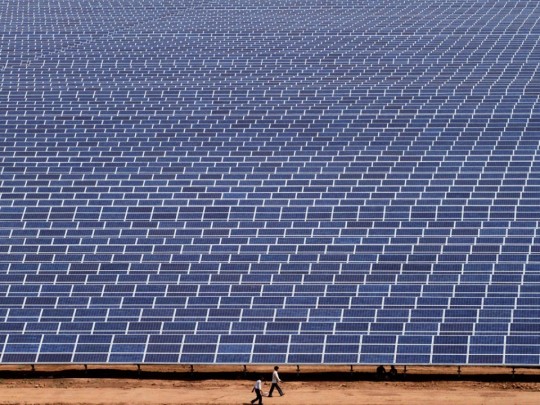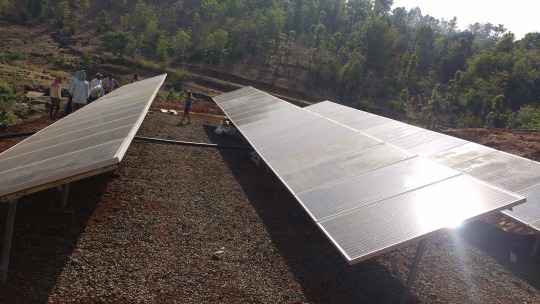#solar power in india
Text

By 2050, Solar panels could be the world's No.1 Source of Power - FreyrEnergy:
What a world it would be!
Solar energy could replace fossil fuels entirely to become the world’s power source by 2050.
For more information related to solar please visit the website: FreyrEnergy
#Types of solar energy#advantages of solar energy#solar system for home#solar panel installation cost#solar panel efficiency#solar panels for home cost#solar panel for home price#solar power in India#solar panel price in india#solar panel installation#solar panels for home#Benefits of solar energy#solar power system#solar panel system#solar structure#solar panel cost#solar energy#hybrid solar system#uses of solar energy#solar power plant#solar panel price#ON grid solar system#Best solar panel in India#Solar companies#Solar panel subsidy#Best solar companies in India#Best solar panel company in India#Solar panel installation cost#Home Solar Panel Systems#Best solar panel company
6 notes
·
View notes
Text

Nimbus is a rooftop solar solutions in india. Contact for any enquiry related to rooftop solar solutions in India.
#solar company in india#solar energy in india#solar panels#solar energy#roof top solar companies#solar power in india#solar power#rooftop solar solutions#rooftop solar solutions in india#rooftop solution
0 notes
Text
Green Power - Indian Solar Energy Companies Contribution to Solar Technology
The audio highlights that Solar energy companies in India are at the forefront of revolutionizing the country's renewable energy landscape. With abundant sunlight and supportive government policies, solar power is thriving. Leading solar companies in India like Adani Green Energy, Tata Power Solar, and ReNew Power are driving innovation and scaling up solar capacity. From advancements in photovoltaic technology to tackling storage challenges, Indian firms are making significant contributions. India's global influence in solar energy is evident through collaborations with entities like the International Solar Alliance and the export of solar technology. Despite challenges, the future looks promising, with ample opportunities for job creation, economic growth, and continued innovation in the solar sector companies in India.
For more info on renewable energy companies, visit the India Brand Equity Foundation website.
#solar india#solar power in India#solar companies in India#renewable energy sources#renewable energy companies#solar energy companies in india#growth of renewable energy#SoundCloud
0 notes
Text
Scientists have developed a new solar-powered system to convert saltwater into fresh drinking water which they say could help reduce dangerous the risk of waterborne diseases like cholera.
Via tests in rural communities, they showed that the process is more than 20% cheaper than traditional methods and can be deployed in rural locations around the globe.
Building on existing processes that convert saline groundwater to freshwater, the researchers from King’s College London, in collaboration with MIT and the Helmholtz Institute for Renewable Energy Systems, created a new system that produced consistent levels of water using solar power, and reported it in a paper published recently in Nature Water.
It works through a process called electrodialysis which separates the salt using a set of specialized membranes that channel salt ions into a stream of brine, leaving the water fresh and drinkable. By flexibly adjusting the voltage and the rate at which salt water flowed through the system, the researchers developed a system that adjusts to variable sunshine while not compromising on the amount of fresh drinking water produced.
Using data first gathered in the village of Chelleru near Hyderabad in India, and then recreating these conditions of the village in New Mexico, the team successfully converted up to 10 cubic meters, or several bathtubs worth of fresh drinking water. This was enough for 3,000 people a day with the process continuing to run regardless of variable solar power caused by cloud coverage and rain.
[Note: Not sure what metric they're using to calculate daily water needs here. Presumably this is drinking water only.]
Dr. Wei He from the Department of Engineering at King’s College London believes the new technology could bring massive benefits to rural communities, not only increasing the supply of drinking water but also bringing health benefits.
“By offering a cheap, eco-friendly alternative that can be operated off the grid, our technology enables communities to tap into alternative water sources (such as deep aquifers or saline water) to address water scarcity and contamination in traditional water supplies,” said He.
“This technology can expand water sources available to communities beyond traditional ones and by providing water from uncontaminated saline sources, may help combat water scarcity or unexpected emergencies when conventional water supplies are disrupted, for example like the recent cholera outbreaks in Zambia.”
In the global rural population, 1.6 billion people face water scarcity, many of whom are reliant on stressed reserves of groundwater lying beneath the Earth’s surface.
However, worldwide 56% of groundwater is saline and unsuitable for consumption. This issue is particularly prevalent in India, where 60% of the land harbors undrinkable saline water. Consequently, there is a pressing need for efficient desalination methods to create fresh drinking water cheaply, and at scale.
Traditional desalination technology has relied either on costly batteries in off-grid systems or a grid system to supply the energy necessary to remove salt from the water. In developing countries’ rural areas, however, grid infrastructure can be unreliable and is largely reliant on fossil fuels...
“By removing the need for a grid system entirely and cutting reliance on battery tech by 92%, our system can provide reliable access to safe drinking water, entirely emission-free, onsite, and at a discount of roughly 22% to the people who need it compared to traditional methods,” He said.
The system also has the potential to be used outside of developing areas, particularly in agriculture where climate change is leading to unstable reserves of fresh water for irrigation.
The team plans to scale up the availability of the technology across India through collaboration with local partners. Beyond this, a team from MIT also plans to create a start-up to commercialize and fund the technology.
“While the US and UK have more stable, diversified grids than most countries, they still rely on fossil fuels. By removing fossil fuels from the equation for energy-hungry sectors like agriculture, we can help accelerate the transition to Net Zero,” He said.
-via Good News Network, April 2, 2024
#water#water scarcity#clean water#saline#desalination#off grid#battery technology#solar power#solar energy#fossil fuels#water shortage#india#hyderabad#new mexico#united states#uk#united kingdom#good news#hope#aquifers
821 notes
·
View notes
Photo

Many Power Sector Companies are present in India. Distribution Utilities Forum (DUF) is an independent discussion forum for electricity distribution utilities in India, launched by Shakti Sustainable Energy Foundation (SSEF) and The Energy and Resources Institute (TERI), to come together and deliberate on the challenges facing the sector and learn from each other’s experiences. http://dufindia.com/
#Power Submission Companies In India#distribution of solar energy in india#power generation companies in India#Solar Power In India#Power Sector Companies
0 notes
Text

Best Power Sector Companies in India. Visit:
0 notes
Text
#india#good news#environmentalism#science#solar panels#solar energy#solar power#climate change#climate crisis
19 notes
·
View notes
Text

Gujarat Solar Park, India
20 notes
·
View notes
Text
youtube
The simple genius of solar canals explained. The southwestern U.S. is in the throes of a “megadrought” so severe that we’ve broken the record — all 1,200 years of it. Researchers from the University of California have proposed a solution that could potentially address both the water and energy crises at the same time: covering irrigation canals with solar panels. But is this just another renewable energy gimmick, or does it hold a little more water? Let’s take a deeper dive to find out.
Watch Solar Panels Plus Farming? Agrivoltaics Explained https://youtu.be/lgZBlD-TCFE?list=PLn...
Video script and citations:
https://undecidedmf.com/how-solar-pan...
Corrections:
07:42 - Should read 238 billion liters, not million
Follow-up podcast:
Video version - https://www.youtube.com/channel/UC4-a...
Audio version - http://bit.ly/stilltbdfm
#Undecided with Matt Ferrell#solarpunk#Solar power#solar panel#USA#india#california#water#drought#water crisis#southwestern#water canal#irrigation canal#Youtube
24 notes
·
View notes
Text
Via APNews.com - "The diesel generator that used to provide emergency backup — spewing planet-warming gases and toxic smoke within breathing distance of newborns every time it was running — is gone. So is the need to use flashlights to see during one of the hospital’s roughly 600 births per year, as staff sometimes had to do amid a sudden blackout if the old generators weren’t working."
8 notes
·
View notes
Text
10 Practical Uses of Solar Power for Residential Homes - FreyrEnergy:

In recent years, solar power has emerged as a versatile and sustainable energy solution for residential homes. From reducing electricity bills to minimizing carbon footprint, the uses of solar power in homes are diverse and practical. Let's delve into 10 practical applications of solar power for residential homes:
Top Uses of Solar Power in Homes:
Let us check the uses of rooftop solar panel in residential, serving as an alternative, renewable, and green energy source.
Alternative Electricity Source:
Solar panels installed on residential rooftops serve as an alternative source of electricity. By harnessing sunlight and converting it into electricity, homeowners can power their appliances and lighting, reducing reliance on traditional grid electricity.
Solar Water Heating:
Solar water heater systems utilize solar energy to heat water for domestic use. These systems are cost-effective and environmentally friendly alternatives to conventional water heaters, providing hot water for bathing, washing, and other household needs.
Solar Cooking:
Solar cookers harness sunlight to cook food without the need for traditional fuel sources such as gas or electricity. They are ideal for outdoor cooking and can be used to prepare a variety of dishes, ranging from simple recipes to elaborate meals.
Solar Ventilation:
Solar-powered ventilation fans help regulates indoor temperature by expelling hot air from attics and other enclosed spaces. By reducing the need for air conditioning, these fans contribute to energy savings and enhance indoor comfort.
Portable Solar Chargers:
Portable solar chargers allow homeowners to harness solar energy system to charge their electronic devices, such as smart phones, tablets, and laptops. These chargers are convenient for outdoor activities and emergencies, providing a reliable power source wherever you go.
Solar Lighting:
Solar-powered lights and lamps illuminate residential spaces without the need for grid electricity. They are ideal for outdoor lighting, landscaping, and decorative purposes, enhancing the aesthetics of homes while reducing energy costs.
Solar Security Systems:
Solar-powered security cameras and lights offer enhanced security for residential properties. These systems utilize solar energy to operate, providing continuous surveillance and deterrence against intruders without relying on grid electricity.
Solar Water Filtration:
Solar-powered water filtration systems purify water using solar energy, making it safe and drinkable for household use. These systems are especially useful in remote areas where access to clean water is limited.
Solar Air Conditioning:
Solar-powered air conditioning systems use solar energy to cool indoor spaces, reducing electricity consumption and environmental impact. These solar power systems are energy-efficient and cost-effective alternatives to traditional air conditioners.
Solar Home Energy Storage:
Solar energy storage systems store excess solar power generated during the day for use during periods of low sunlight or high energy demand. These residential solar panel systems help homeowners maximize their solar energy savings and achieve greater energy independence.
Conclusion:
The uses of solar power for residential homes are numerous and practical, offering homeowners an opportunity to reduce their energy costs, carbon footprint, and reliance on traditional energy sources. With advancements in solar technology and increased awareness of environmental sustainability, solar power is poised to play a crucial role in shaping the future of residential energy consumption.
Freyr Energy, a leader in solar panel system solutions, is dedicated to making solar power accessible and affordable for homeowners across India. With their expertise and support, homeowners can seamlessly integrate solar power into their homes, reducing electricity costs and promoting environmental conservation. Embrace the power of solar panels for home and take the first step towards a greener and more sustainable future.
#uses of solar power#rooftop solar panel#solar water heater#solar energy systems#solar energy system#solar panel systems#solar technology#solar panels for home#solar panel system#solar power system#solar power systems#solar panel price#solar energy in india#solar power in india#solar panel rate#solar panel cost
1 note
·
View note
Text

Nimbus is rooftop solar company specialising in solar rooftop solutions.
#solar company in india#solar energy in india#solar panels#solar energy#solar power in india#solar power#roof top solar companies#rooftop solar solutions in india#rooftop solar solutions#rooftop solution
1 note
·
View note
Text
How Solar Energy Schemes and Benefits in India Can Save You Money and the Planet
Want to save money and the planet with solar energy? Check out latest article on solar energy schemes and benefits in India and learn how you can take advantage of them today! #SolarEnergyIndia solar-energy-schemes-and-benefits-in-india
What is solar energy and why is it important for India ?
Solar energy potential in India
Solar energy is one of the most promising sources of renewable energy for Bharat (India), which has abundant sunlight and a huge population. In this article, we will explore some of the solar energy schemes and benefits in (Bharat) India that can help you save money on your electricity bills, reduce your…

View On WordPress
#benefits#challenges#green energy#how to get solar panels in India#India#opportunities#renewable energy#schemes#solar energy#solar energy benefits in India#solar energy schemes in India#solar panels#solar power#solar power in India
0 notes
Text
vimeo
Green Power - Indian Solar Energy Companies Contribution To Solar Technology
India is emerging as a global leader in solar energy, capitalizing on its geographic advantage of abundant sunlight & supported by proactive government initiatives. The solar power in India is witnessing exponential growth, with ambitious targets to expand solar capacity to 100 GW by 2022. Leading solar energy companies like Tata Power Solar Systems Ltd and ReNew Power Pvt. Ltd are driving this growth through innovation in photovoltaic technology. Despite challenges such as land acquisition & regulatory hurdles, the growth of the renewable energy sector offers vast opportunities for job creation, economic growth, & innovation. Solar companies in India contribute to global solar energy, through technology export & international collaborations.
#solarindia#solar energy companies in india#solar companies in India#solar power in India#renewable energy sources#renewable energy companies#Vimeo
0 notes
Text
"India’s announcement that it aims to reach net zero emissions by 2070 and to meet fifty percent of its electricity requirements from renewable energy sources by 2030 is a hugely significant moment for the global fight against climate change. India is pioneering a new model of economic development that could avoid the carbon-intensive approaches that many countries have pursued in the past – and provide a blueprint for other developing economies.
The scale of transformation in India is stunning. Its economic growth has been among the highest in the world over the past two decades, lifting of millions of people out of poverty. Every year, India adds a city the size of London to its urban population, involving vast construction of new buildings, factories and transportation networks. Coal and oil have so far served as bedrocks of India’s industrial growth and modernisation, giving a rising number of Indian people access to modern energy services. This includes adding new electricity connections for 50 million citizens each year over the past decade.
The rapid growth in fossil energy consumption has also meant India’s annual CO2 emissions have risen to become the third highest in the world. However, India’s CO2 emissions per person put it near the bottom of the world’s emitters, and they are lower still if you consider historical emissions per person. The same is true of energy consumption: the average household in India consumes a tenth as much electricity as the average household in the United States.
India’s sheer size and its huge scope for growth means that its energy demand is set to grow by more than that of any other country in the coming decades. In a pathway to net zero emissions by 2070, we estimate that most of the growth in energy demand this decade would already have to be met with low-carbon energy sources. It therefore makes sense that Prime Minister Narendra Modi has announced more ambitious targets for 2030, including installing 500 gigawatts of renewable energy capacity, reducing the emissions intensity of its economy by 45%, and reducing a billion tonnes of CO2.
These targets are formidable, but the good news is that the clean energy transition in India is already well underway. It has overachieved its commitment made at COP 21- Paris Summit [a.k.a. 2015, at the same conference that produced the Paris Agreement] by already meeting 40% of its power capacity from non-fossil fuels- almost nine years ahead of its commitment, and the share of solar and wind in India’s energy mix have grown phenomenally. Owing to technological developments, steady policy support, and a vibrant private sector, solar power plants are cheaper to build than coal ones. Renewable electricity is growing at a faster rate in India than any other major economy, with new capacity additions on track to double by 2026...
Subsidies for petrol and diesel were removed in the early 2010s, and subsidies for electric vehicles were introduced in 2019. India’s robust energy efficiency programme has been successful in reducing energy use and emissions from buildings, transport and major industries. Government efforts to provide millions of households with fuel gas for cooking and heating are enabling a steady transition away from the use of traditional biomass such as burning wood. India is also laying the groundwork to scale up important emerging technologies such as hydrogen, battery storage, and low-carbon steel, cement and fertilisers..."
-via IEA (International Energy Agency), January 10, 2022
Note: And since that's a little old, here's an update to show that progress is still going strong:
-via Economic Times: EnergyWorld, March 10, 2023
#india#solar power#renewable energy#green energy#sustainability#wind power#population grown#economic growth#developing economies#renewable electricity#carbon emissions#good news#hope#hope posting
856 notes
·
View notes
Text
India Approves Massive $9 Bil. Rooftop Solar Plan with Panels for 10 Million Homes https://www.goodnewsnetwork.org/india-approves-massive-9-bil-rooftop-solar-plan-with-panels-for-10-million-homes/
#good news#science#environment#nature#india#solar#solar panels#solar power#green power#climate change#climate crisis
10 notes
·
View notes